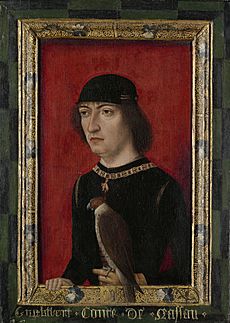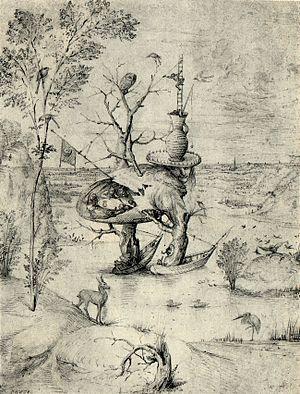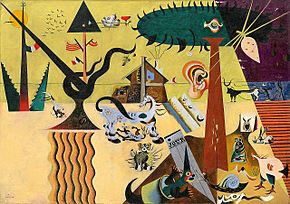The Garden of Earthly Delights facts for kids
The Garden of Earthly Delights is the modern title given to a triptych oil painting on oak panel painted by the Early Netherlandish master Hieronymus Bosch, between 1490 and 1510, when Bosch was between 40 and 60 years old. It has been housed in the Museo del Prado in Madrid, Spain since 1939.
Bosch painted three large triptychs (the others are The Last Judgment of c. 1482 and The Haywain Triptych of c. 1516) that can be read from left to right and in which each panel was essential to the meaning of the whole. Each of these three works presents distinct, yet linked themes addressing history and faith. Triptychs from this period were generally intended to be read sequentially, the left and right panels often portraying Eden and the Last Judgment respectively, while the main subject was contained in the center piece. It is not known whether The Garden was intended as an altarpiece, but the general view is that the extreme subject matter of the inner center and right panels make it unlikely that it was intended to function in a church or monastery, but was instead commissioned by a lay patron.
Description
Exterior
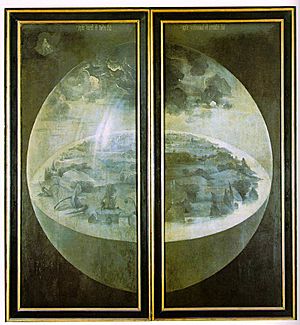
When the triptych's wings are closed, the design of the outer panels becomes visible. Rendered in a green–gray grisaille, these panels lack colour, probably because most Netherlandish triptychs were thus painted, but possibly indicating that the painting reflects a time before the creation of the sun and moon, which were formed, according to Christian theology, to "give light to the earth". The typical grisaille blandness of Netherlandish altarpieces served to highlight the splendid color inside.
The outer panels are generally thought to depict the creation of the world, showing greenery beginning to clothe the still-pristine Earth. God, wearing a crown similar to a papal tiara (a common convention in Netherlandish painting), is visible as a tiny figure at the upper left. Bosch shows God as the father sitting with a Bible on his lap, creating the Earth in a passive manner by divine fiat. Above him is inscribed a quote from Psalm 33:9 reading "Ipse dīxit, et facta sunt: ipse mandāvit, et creāta sunt"—For he spoke and it was done; he commanded, and it stood fast. There is a firmament around the Earth, in reference to Genesis 1:7It hangs suspended in the cosmos, which is shown as an impermeable darkness, whose only other inhabitant is God himself.
Despite the presence of vegetation, the earth does not yet contain human or animal life, indicating that the scene represents the events of the biblical Third Day. Bosch renders the plant life in an unusual fashion, using uniformly gray tints which make it difficult to determine whether the subjects are purely vegetal or perhaps include some mineral formations. Surrounding the interior of the globe is the sea, partially illuminated by beams of light shining through clouds. The exterior wings have a clear position within the sequential narrative of the work as a whole. They show an unpopulated earth composed solely of rock and plants.
Interior
Scholars have proposed that Bosch used the outer panels to establish a Biblical setting for the inner elements of the work, and the exterior image is generally interpreted as set in an earlier time than those in the interior. As with Bosch's Haywain Triptych, the inner centerpiece is flanked by heavenly and hellish imagery. The scenes depicted in the triptych are thought to follow a chronological order: flowing from left-to-right they represent Eden, the garden of earthly delights, and Hell. God appears as the creator of humanity in the left hand wing, while the consequences of humanity's failure to follow his will are shown in the right.
Dating and provenance

The dating of The Garden of Earthly Delights is uncertain. Ludwig von Baldass (1917) considered the painting to be an early work by Bosch. However, since De Tolnay (1937) consensus among 20th-century art historians placed the work in 1503–1504 or even later. Both early and late datings were based on the "archaic" treatment of space. Dendrochronology dates the oak of the panels between the years 1460 and 1466, providing an earliest date (terminus post quem) for the work.
Wood used for panel paintings during this period customarily underwent a lengthy period of storage for seasoning purposes, so the age of the oak might be expected to predate the actual date of the painting by several years. Internal evidence, specifically the depiction of a pineapple (a "New World" fruit), suggests that the painting itself postdates Columbus' voyages to the Americas, between 1492 and 1504. The dendrochronological research brought Vermet to reconsider an early dating and, consequently, to dispute the presence of any "New World" objects, stressing the presence of African ones instead.
The Garden was first documented in 1517, one year after the artist's death, when Antonio de Beatis, a canon from Molfetta, Italy, described the work as part of the decoration in the town palace of the Counts of the House of Nassau in Brussels. The palace was a high-profile location, a house often visited by heads of state and leading court figures. The prominence of the painting has led some to conclude that the work was commissioned, and not "solely ... a flight of the imagination". A description of the triptych in 1605 called it the "strawberry painting", because the fruit of the strawberry tree (madroño in Spanish) features prominently in the center panel.
The aristocracy of the Burgundian Netherlands, influenced by the humanist movement, were the most likely collectors of Bosch's paintings, but there are few records of the location of his works in the years immediately following his death. It is probable that the patron of the work was Engelbrecht II of Nassau, who died in 1504, or his successor Henry III of Nassau-Breda, the governor of several of the Habsburg provinces in the Low Countries. De Beatis wrote in his travel journal that "there are some panels on which bizarre things have been painted. They represent seas, skies, woods, meadows, and many other things, such as people crawling out of a shell, others that bring forth birds, men and women, white and blacks doing all sorts of different activities and poses."
Because the triptych was publicly displayed in the palace of the House of Nassau, it was visible to many, and Bosch's reputation and fame quickly spread across Europe. The work's popularity can be measured by the numerous surviving copies—in oil, engraving and tapestry—commissioned by wealthy patrons, as well as by the number of forgeries in circulation after his death. Most are of the central panel only and do not deviate from the original. These copies were usually painted on a much smaller scale, and they vary considerably in quality. Many were created a generation after Bosch, and some took the form of wall tapestries.
The De Beatis description, only rediscovered by Steppe in the 1960s, cast new light on the commissioning of a work that was previously thought—since it has no central religious image—to be an atypical altarpiece. Many Netherlandish diptychs intended for private use are known, and even a few triptychs, but the Bosch panels are unusually large compared with these and contain no donor portraits. Possibly they were commissioned to celebrate a wedding, as large Italian paintings for private houses frequently were. Nevertheless, The Garden's bold depictions do not rule out a church commission, such was the contemporaneous fervor to warn against immorality. In 1566, the triptych served as the model for a tapestry that hangs at El Escorial monastery near Madrid.
Upon the death of Henry III, the painting passed into the hands of his nephew William the Silent, the founder of the House of Orange-Nassau and leader of the Dutch Revolt against Spain. In 1568, however, the Duke of Alba confiscated the picture and brought it to Spain, where it became the property of one Don Fernando, the Duke's illegitimate son and heir and the Spanish commander in the Netherlands. Philip II acquired the painting at auction in 1591; two years later he presented it to El Escorial. A contemporaneous description of the transfer records the gift on 8 July 1593 of a "painting in oils, with two wings depicting the variety of the world, illustrated with grotesqueries by Hieronymus Bosch, known as 'Del Madroño'".
After an unbroken 342 years at El Escorial, the work moved to the Museo del Prado in 1939, along with other works by Bosch. The triptych was not particularly well-preserved; the paint of the middle panel especially had flaked off around joints in the wood. However, recent restoration works have managed to recover and maintain it in a very good state of quality and preservation. The painting is normally on display in a room with other works by Bosch.
Sources and context
Little is known for certain of the life of Hieronymus Bosch or of the commissions or influences that may have formed the basis for the iconography of his work. His birthdate, education and patrons remain unknown. There is no surviving record of Bosch's thoughts or evidence as to what attracted and inspired him to such an individual mode of expression. Through the centuries art historians have struggled to resolve this question yet conclusions remain fragmentary at best. Scholars have debated Bosch's iconography more extensively than that of any other Netherlandish artist. His works are generally regarded as enigmatic, leading some to speculate that their content refers to contemporaneous esoteric knowledge since lost to history.
Although Bosch's career flourished during the High Renaissance, he lived in an area where the beliefs of the medieval Church still held moral authority. He would have been familiar with some of the new forms of expression, especially those in Southern Europe, although it is difficult to attribute with certainty which artists, writers and conventions had a bearing on his work.
The period in which the triptych was created was a time of adventure and discovery, when tales and trophies from the New World sparked the imagination of poets, painters and writers. Although the triptych contains many unearthly and fantastic creatures, Bosch still appealed in his images and cultural references to an elite humanist and aristocratic audience. Bosch reproduces a scene from Martin Schongauer's engraving Flight into Egypt.
Conquest in Africa and the East provided both wonder and terror to European intellectuals, as it led to the conclusion that Eden could never have been an actual geographical location. The Garden references exotic travel literature of the 15th century through the animals, including lions and a giraffe, in the left panel. The giraffe has been traced to Cyriac of Ancona, a travel writer known for his visits to Egypt during the 1440s. The exoticism of Cyriac's sumptuous manuscripts may have inspired Bosch's imagination.
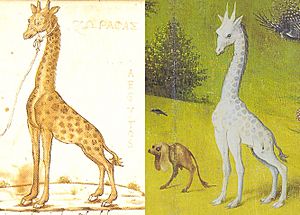
The charting and conquest of this new world made real regions previously only idealised in the imagination of artists and poets. At the same time, the certainty of the old biblical paradise began to slip from the grasp of thinkers into the realms of mythology. In response, treatment of the Paradise in literature, poetry and art shifted towards a self-consciously fictional Utopian representation, as exemplified by the writings of Thomas More (1478–1535).
Legacy
Because Bosch was such a unique and visionary artist, his influence has not spread as widely as that of other major painters of his era. However, there have been instances of later artists incorporating elements of The Garden of Earthly Delights into their own work. Pieter Bruegel the Elder (c. 1525–1569) in particular directly acknowledged Bosch as an important influence and inspiration, and incorporated many elements of the inner right panel into several of his most popular works.
During the early 20th century, Bosch's work enjoyed a popular resurrection. The early surrealists' fascination with dreamscapes, the autonomy of the imagination, and a free-flowing connection to the unconscious brought about a renewed interest in his work. Bosch's imagery struck a chord with Joan Miró and Salvador Dalí in particular. Both knew his paintings firsthand, having seen The Garden of Earthly Delights in the Museo del Prado, and both regarded him as an art-historical mentor.
When André Breton wrote his first Surrealist Manifesto in 1924, his historical precedents as inclusions named only Gustave Moreau, Georges Seurat, and Uccello. However, the Surrealist movement soon rediscovered Bosch and Bruegel, who quickly became popular among the Surrealist painters. René Magritte and Max Ernst both were inspired by Bosch's The Garden of Earthly Delights.
See also
 In Spanish: El jardín de las delicias para niños
In Spanish: El jardín de las delicias para niños
- List of paintings by Hieronymus Bosch


